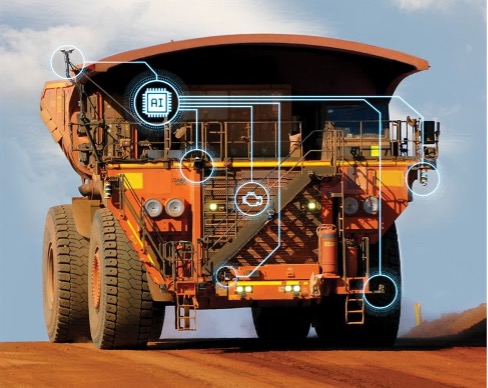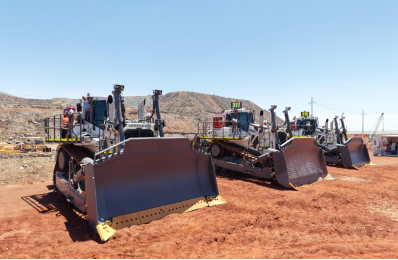A blend of gold
Pop quiz: what do you get when you combine first-rate exploration expertise with mining operational smarts? Great corporate governance and superb technical staff?
Those questions were quickly answered in September when Vancouver-based B2Gold and Australia’s CGA Mining Limited announced a merger that will boost B2’s gold producing portfolio and help CGA expand a proven gold resource in the Philippines.
Both companies are bullish about what each brings to the table.
“We don’t have that strong of a track record of exploration and skill set within the group to mentor and drive a good exploration program, said CGA CEO Mark Turner. “B2 brings that exploration expertise.”
“We saw they had a good project in a jurisdiction we were happy with,” says B2Gold VP of Investor Relations Ian MacLean. “They’ve built a really good mine and it’s well run.” B2Gold CEO Clive Johnson couldn’t be happier either. “There’s a really great team there. That’s one of the best things about this acquisition.”
The centrepiece driving all this glowing goodwill is the Masbate Mine.
Set on the Phillipine island of the same name and opened in May 2009, the Masbate produced more than 150,000 ounces of gold in its first year of operation. With a likely mining reserve of 3.03 million ounces of gold, the mine is forecast to produce 200,000 ounces per annum over the next two decades.
“We’re very excited about it,” MacLean enthuses. “This whole deal more than doubles our production. Beyond that we’ll also be watching for what opportunities there are to optimize production.”
Rebuilding from the ground up…
The Masbate is a conventional truck and shovel open pit mine, purchased by CGA in 2007, sitting at the northern tip of Masbate Island, 350 km south of Manila. CGA hired Leighton Contractors, Australia’s largest project development and construction group, to upgrade the mine, but nothing, says Mark Turner, could have prepared them for what they’d see on the ground the day technical staff arrived to do their survey. Most of the existing infrastructure “was beyond repair,” said Turner: The mill, crushers and power house needed complete replacement and the mining camp thorough refurbishing.
“And in the confirmatory drilling that we did, it actually showed that the old mill and crusher’s structure and power house were actually located on ore bodies so the decision was to move the location of the mill. All the old plant and power house, everything was broken down and scrapped.”
Rebuilt from the ground up in less than two years at a total capital expenditure of approximately US$178 million, the Masbate today is the largest operating gold project in the Philippines. Its process plant is a conventional carbon-in-leach facility consisting of a primary crushing, two-stage grinding and leaching process with electrowinning and smelting gold recovery. Power is supplied by a new 30 MW power station, featuring five Wartsila gen sets.
“From the very time we cranked the mill up there was capacity within the equipment there and with a couple of minor tweaks to really get a lot more out of this plant than the original design suggested. We took it from a 4 million tonne per year plant up to around 5.5 million tonnes.”
With an eye to increasing throughput even more, CGA spent an additional $12 million on upgrades, including $3 million for construction of a supplementary, three-stage crushing circuit. “This allowed us to put better equipment and spares and large rotable motors in place to bring up our viabilities as well,” says Turner. Producing about 400 tonnes per hour, the new crusher helped increase overall production by an additional one million tonnes per year. “The new crusher was added in recognition that as the pit gets deeper and the ore gets harder, we get a reduction in the capacity of the sag mill.” The supplementary crusher, he added, crushes the hard rock down to
12 mm which is then fed through the sag mill directly into the two balls mills.
“We use the extra capacity in the ball mills and we’ve still got the sag mill at full capacity as well. So at this point, it doesn’t matter whether we feed a blend of soft and hard or feed hard dirt; it doesn’t matter what sort of dirt we throw at it, we can maintain that 6.5 million tonne per annum.”
Leighton provides all major equipment on site, including fourteen 100-tonne Cat 777 dump trucks, six 50-tonne 773 Cat dump truck, two 200-tonne Cat back hoe excavators, two D9 and D8 dozers, graders and associated equipment. Feeding the crusher are three Cat 988 loaders.
Above and beyond the call…
One thing CGA didn’t count on in July 2011 was a problem at the SAG Mill. The Masbate was obviously a very good prospect and to get it up and running CGA had procured and refurbished second-hand milling equipment (e.g. sag mill, drive trains and ball mills); but where contemporary mills are designed so that contact between the shell and the head of the mill is a bolted flange joint, older designed mills like the original Masbate mine used a welded joint. That is where the problem occurred, says Turner.
“The weld between the shell and head of the sag Mill cracked both at the fleet and discharge ends. So we instantly shut the mill down.”
Interim production was re-established on July 21, 2011 by reconfiguring the grinding circuit and feeding ore directly into the ball mills. Meantime, international engineers Metso Minerals spent six months supervising the re-welding of the joints between the shell and head of the sag Mill.
Turner says CGA and Metso “were absolutely meticulous” about ensuring the structural integrity of the new joints. Ultra-sonic testing was conducted throughout and the “slightest little blemish in the weld” addressed, says Turner.
“Even though it would pass world standards, we grouted out and did it again so that we got this weld on both the feed and discharge ends significantly better than how it was originally done.”
In addition to perfecting the welds, CGA installed engineered gussets which knitted the rotating element to the mill heads to ensure improved structural integrity to the mill shell. With repairs to the SAG Mill finished on December 25, 2011, and recommissioning completed within a few days, production rates rose from 350 tph to 700 tph. Every mechanical check showed the circuit running smoothly and back at full operating capacity.
“Since we brought it on line in December,” Turner says proudly, “we’ve averaged just over 6.8 million tonnes through that mill.”
Looking at options…
It’s one thing to have a mine fully operational and turning out ore values lickety split, but what adds to the excitement is the possibility for expansion. With 188 million tonnes of reserve and 20 years of mine life to recover over 3 million ounces of gold, questions remain over how to maximize throughput given large scale, lower grade ore bodies. So, for the last 12 months, CGA has been examining where the next production point in the mill expansion might be.
The logical number, says Turner, was at the 10 or 11 million tonne per annum mark.
“What that would allow us to do is to mine comfortably at that rate without further exploration. And you could still mine within the current peak geometries at an acceptable speed without compromising your ore body or putting your mining fleet under unnecessary stress.”
But while, from an actual mining perspective, very little changed, additional c
apacity was still required at the mill. CGA considered building a brand new 11 MW sag Mill and 8 MW ball mills and making the current crushing and grinding circuit completely redundant, all at an approximate cost of $170 million. This, they considered, too high a cost. Since then, the company has come up with an optimization study to determine if it could add extra ball mills, expand the current crushing circuit, and still maintain production levels.
The study suggests the most cost-effective and most efficient way to get to that 10 or 11 million tonne per annum is to build a crushing and grinding circuit right beside the one currently in place, says Turner.
“Obviously this is something B2’s gotta look at, but that’s one approach that could be very cost effective.” A second circuit “mirroring” the existing circuit, says Turner, could potentially give B2Gold an extra 4.5 to 5 million tonnes per annum at a cost of about $130 million, including approximately extra 20 MW of power.
For his part, Clive Johnson says once the merger is finalized (Under Australian law such agreements are subject to an Independent Expert opinion to ensure shareholders are protected) expansion is a good idea. To that end, B2Gold will reveal its plans for expanding Masbate in the first quarter of 2013.
“We think it has a potential to expand,” says Johnson. “It has a very long mine life; it’s got a very solid 3 million ounce reserve and a lot of resources that we think could become reserves. So the exploration potential is very extensive.





Comments